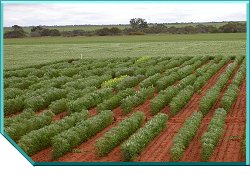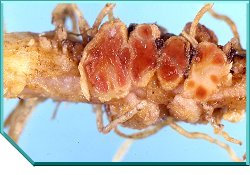EXPLORE

    |

Underpinning Science
A large body of scientific endeavour forms the basis for the on-going genetic improvement, agronomic advances and better utilisation of the lupin grain.
![]()
Domestication
 In their wild state lupins have ‘hard’ (water impermeable) seeds and shattering pods to aid dispersal and enhance their long-term survival. High levels of alkaloids are also present as part of a natural defence mechanism against insects and other herbivores. The first steps in modern lupin breeding began in Germany in 1928 when Von Sengbusch identified natural mutants in L. luteus with low alkaloids, which reduced the toxicity of the seed, and water-permeable seeds and non-shattering pods to facilitate mechanical agriculture.
In their wild state lupins have ‘hard’ (water impermeable) seeds and shattering pods to aid dispersal and enhance their long-term survival. High levels of alkaloids are also present as part of a natural defence mechanism against insects and other herbivores. The first steps in modern lupin breeding began in Germany in 1928 when Von Sengbusch identified natural mutants in L. luteus with low alkaloids, which reduced the toxicity of the seed, and water-permeable seeds and non-shattering pods to facilitate mechanical agriculture.
These 'domestication' genes have now been combined in L. albus, L. angustifolius, L. mutabilis, L. cosentinii, L. atlanticus and L. pilosus.
Reference:
Gladstones, J. S. (1998) Distribution, origin, taxonomy, history and importance. IN Lupins as crop plants: biology, production and utilization., (Editors: Gladstones, J. S., Atkins, C. A. & Hamblin, J. pp. 1-37. CAB International.
Breeding Programs
|
Some programs belong to private companies and others are government or university based.
Australia
Link: Lupin Breeding WA.pdf
www.dpi.nsw.gov.au/agriculture
Chile
Germany
Genetic Resource Collections
International Lupin Collection, South Perth Australia
The Institute of Plant Genetics & Crop Plant Research Germany
Genomics & Molecular Breeding
Transformation
Molecular transformation systems for lupins have been well developed at CLIMA (Centre for Legumes in Mediterranean Agriculture) in Perth and Canberra, Australia. Some transformed lupins have been produced and evaluated under strict guidelines of the Australian Government’s Office of the Gene Technology Regulator (OGTR). Lines with enhanced seed protein profiles, herbicide tolerance and putative disease resistance have been developed. There has been no commercial release of a Genetically Modified (GM) lupin in Australia or any other country at this point in time.
Molecular mapping
Molecular mapping research and marker assisted selection is developing, particularly in Australia and Europe. Collaboration exists with international genomics consortia working with the model legume Medicago truncatula.
Reference:
Phan, HTT et al. (2006). Differences in syntenic complexity between Medicago truncatula with Lens culinaris and Lupinus albus. Functional Plant Biology 33: 775-782.
Marker assisted selection
The Australian breeding program routinely implements an MFLP marker for anthracnose resistance in L. angustifolius and is in the process of validating markers for the domestication genes and phomopsis resistance.
Reference:
Boersma, J. et al (2005) Construction of a genetic linkage map using MFLP and identification of molecular markers linked to domestication genes in narrow-leafed lupin (Lupinus angustifolius L.). Cell Mol Biol Lett.10(2):331-344.
www.cropscience.org.au/icsc2004/poster/3/4/1/312_yangh.htm
PDF and internet Resources
Australian Lupin collection 2003 annual report
This is the 2003 Annual Report of the Australian Lupin collection prepared by the Western Australian Department of Agriculture and Food.
CSIRO research into lupins
Legume research
This is the website of the CSIRO detailing their research into Lupins.
CLIMA research projects including mapping of lupin genome - list
Adobe Acrobat Document
91kb PDF (left click to download)
This file shows the funding sources and projects conducted by CLIMA in 2003/04
Investment in Albus lupin breeding by the Council of Grain Grower Organisations (COGGO)
Coggo Article
COGGO has made a significant investment into breeding Albus lupin varieties with improved tolerance of the Anthracnose disease which arrived in Western Australia in 1996 and decimated the industry. The main variety at the time was Kiev Mutant which had virtually no tolerance the disease.
![]()
|
Soil types
Generally lupins prefer slightly acidic or neutral, well drained, friable soils of reasonable depth. Lupin species vary in their sensitivity to soil pH and waterlogging.
|
Soil-type – Lupin species adaptation |
||||
| Soil factor | Least adapted | --> | --> | Most adapted |
| Low pH (high Al) | L. albus | L. angustifolius | L. luteus | |
| High pH (high HCO3-) | L. angustifolius | L. luteus | L. albus | L. pilosus |
| Transient waterlogging | L. albus | L. atlanticus | L. angustifolius | L. luteus |
| Low fertility (sandy soils) | L. albus | L. angustifolius | L. luteus | |
Western Australia
L. angustifolius grows best on deep yellow loamy sands (for example Northern ‘Eradu’ Sandplain) and friable sandy loams (eg Wongan Hills yellow sandy loams). Unsuitable soils include deep white or grey sands where nutritional deficiencies and poor water holding capacities become limiting and shallow duplex or heavy clays with poor physical structure and poor drainage. In heavy or shallow soils, roots develop poorly and the plants prematurely collapse from drought in spring.
L. albus prefers loamy soils (for example Chapman and Avon Valley red loams) with a higher natural fertility but are very sensitive to waterlogging.
Link to 'Narrow leafed lupins: Soil requirements in Australia.PDF'
![]()
|
Lupins fix atmospheric nitrogen in root nodules formed by the soil bacterium Bradyrhizobium. This symbiosis is considered very robust in terms of edaphic and climatic influences and is probably part of the reason why lupins often thrive in relatively infertile soils. The symbiosis is very tolerant of low soil pH but can become limiting at pH > 8, particularly in L. angustifolius.
In agriculture, inoculants containing selected strains of Bradyrhizobia can be applied with the seed or in the planting furrow to ensure adequate nodulation occurs.
Generally the same strain of Bradyrhizobia will nodulate and fix nitrogen across all the economically important lupin species. However, some strain specialisation has been detected, most notably in the species L. princei. Many commercial lupin inoculants also Ornithopus spp. which are important pasture species in parts of the Mediterranean and Australia.
Quantities of nitrogen fixed have been estimated using different methodologies and range from 20 – 400 kg N ha-1. The net nitrogen input (total fixed – removed in harvested grain) from L. angustifolius in Western Australia is believed to range from 32 – 96 kg N ha-1.
Centre for Rhizobium Studies (Murdoch University):
www.scieng.murdoch.edu.au/centres/crs/2003/CRS_AnnualRep_03_04.pdf


